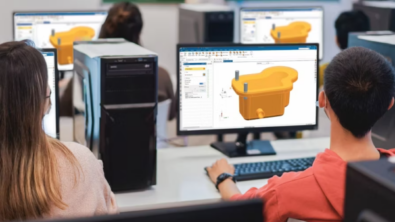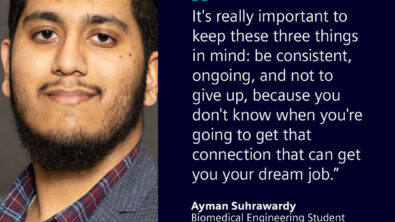Breaking educational barriers for people with disabilities

The University of Cincinnati uses NX to provide students with IDD with the tools to succeed in a STEM-based career
At the University of Cincinnati (UC), providing inclusive and equal access to education to all students is a key driving factor. To accomplish this goal, the university created engaging and enriching educational experiences for those with disabilities by establishing the Intellectual and Developmental Disabilities Education Center (IDD Education Center) in 2014.
Since then, not only has UC launched an education center to ensure people with IDD have access to a general education, but the university has also broken barriers for providing inclusive access to an education in science, technology, engineering and mathematics (STEM). To accomplish this, in 2019, Dr. Christopher Atchison conducted a STEM accessibility workshop. He gathered families, people with disabilities, corporations, educators, agencies and nonprofits to explore and discuss the barriers to providing people with IDD access to a STEM education and ways to overcome them.
This event led to the IDD Education Center’s team meeting with Hugues Bertrand, the fellow model-based system engineering (MBSE) solution architect and consultant at Siemens Digital Industries Software, and the former Siemens employee resource group (ERG) lead. With the same goals in mind, they worked together to develop a curriculum and training opportunities for students with IDD. This includes learning and applying NX™ software, which is part of the Siemens Xcelerator business platform of software, hardware and services. The partnership between Siemens and the IDD Education Center has helped people with IDD overcome the obstacles to receiving a STEM-based education.
Creating inclusivity one program at a time
The IDD Education Center offers programs and conducts research to improve outcomes for people with IDD. These initiatives deal with independent living, health and wellness, social skills development and employment and serve roughly 175 individuals annually. The education center has three specific programs:
- The Collaboration for Education and Employment Synergy (CEES) program provides pathways into hospitality, computer science and engineering for over 120 high school students with IDD annually
- The IMPACT Innovation program provides 25 adults with IDD who have complex communication, sensory and behavioral needs with a place to engage in a variety of work-based learning, lifelong learning and health related activities
- The Transition and Access Pathways (TAP) program provides a four-year comprehensive transition program for 30 students with IDD, where they can explore career opportunities and work-based learning experiences and earn a university-recognized certificate
Despite these beneficial programs, there was a gap in providing students with IDD access to a STEM education. Bridging this gap was the main motivation behind the STEM accessibility workshop. One of the main challenges was overcoming the stigma that people with disabilities are less capable or unable to engage in STEM-based careers. After zeroing in on this overarching issue, the stakeholders knew that a cultural shift was necessary and that people with disabilities can be successful in STEM when given access to the right tools and opportunities.
Paving the way for STEM career pathways
Opening the pathways to STEM education for more people with a variety of experiences and backgrounds is important for spurring innovation, increasing inclusivity and combating unemployment in technical fields. As the world continues to become more entrenched in science and technology, STEM-related fields continue to grow and require more technical workers.
Meeting the growing demand to fill these positions requires education and training. In turn, this means providing STEM education and training that is accessible and available to everyone, especially those from underrepresented groups. One notably overlooked group are individuals with IDD. Students with disabilities often struggle with participating in STEM-related courses due to various challenges, from educators lacking inclusive teaching methods and skills to students having limited experience with accessibility tools. Overcoming these limitations means creating easily accessible, novel strategies and resources to provide opportunities for students to succeed. Most people can succeed and leverage their strengths and abilities to flourish in a STEM-based field, especially when accessibility is a focus. Providing accessibility features and capabilities often benefits everyone, not just the person with the disability.
“Companies in the STEM industry are stressed about finding enough skilled employees,” says Bertrand. “It makes business sense to explore the feasibility of including additional talent pools by tapping into high-capacity, competent, non-bachelor neurodiverse candidates, trained on Siemens products. This also includes reaching out to neurodiverse young adults with bachelor’s degrees via adaptive interviews and work environments.”
Together, Siemens and the IDD Education Center aim to address the critical need to establish accessible STEM career pathways that create opportunities for individuals with disabilities.
Teaming up for STEM accessibility
Before the STEM accessibility workshop at the University of Cincinnati and partnering with Siemens, STEM curriculum and training did not exist for students with IDD. However, collaboration was the key to success.
One goal for the IDD Education Center’s team was to work with faculty from the University of Cincinnati’s College of Engineering to modify their Developing Spatial Thinking (DST) course. This course is mandatory for all engineering students to develop the visual-spatial skills necessary for a STEM related field. This course was an optimal starting point for increasing accessibility since it is a gateway for entering STEM education. The IDD Education Center’s team of specialized educators adapted the course to be more accessible to students with IDD.
Subsequently, the IDD Education Center received funding from the Ohio Department of Education, allowing them to develop and pilot a STEM program called “STEM Access for All” during the 2022 summer semester. In this program, students completed the DST coursework and applied the visual-spatial skills they were learning using NX software. Additionally, Siemens employees volunteered to support and coach students, helping them understand the real-world application of these skills and how they apply to potential careers. Working with the Siemens coaches was engaging and motivating for the students.
Some specific examples from the program include:
- Cindy Ross, a quality assurance (QA) engineer at Siemens, showed the general process for meshing and analyzing a 3D part made in NX. Additionally, Ross worked with students to create user interface (UI) widgets to run a macro in Microsoft Excel, used a Python script to manipulate a file and taught students to use Excel or Tableau to manipulate and analyze data
- Adam Hiller, a computer-aided design (CAD) engineer at Siemens, taught students how to design a part in NX and print it using a 3D printer. Additionally, Hiller worked with students on the important skill of technical presales expo- sure, which is speaking about a product intelligently to someone who does not know what it is
After this first event, STEM Access for All is still helping educate students via the CEES program, which is now a state-recognized pre-apprenticeship program. These pre-ap- prenticeship programs provide an alternative graduation pathway for struggling students. With the CEES program, students gain the technical skills they need to be successful after high school at their own pace. Students can also add certifications to their resumes and portfolios, demonstrating they are ready for employment.
Thanks to help from Siemens, UC and all over Ohio, the IDD Education Center was able to break the first barriers towards creating inclusive and accessible STEM education for all students.
Enabling a brighter future
The IDD Education Center’s goal is to establish sustainable partnerships, like Siemens, for their participants. Thinking and collaborating creatively to develop customized employment opportunities helps address the shortage of workers in the STEM field and provides meaningful employment opportunities for people with IDD. By securing grant funding, establishing buy-in from industry partners and exposing students to STEM curriculum at an early age, it is necessary to keep moving this important work forward, creating an inclusive community where people with diverse abilities have access to new opportunities.


